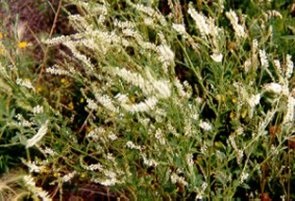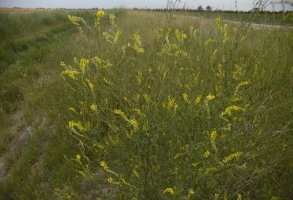Cover crops: sweet clover
Information on the benefits and growth habits of sweet clover planted as a cover crop.
Description
Family
- Leguminosae; species Melilotus spp.
Growth habits
Germination
- White sweet clover have hard shells and need to be scarified prior to germination
- Require the same strain of rhizobial bacteria as alfalfa for inoculation
Top Growth
- Yellow sweet clover: 30–280 cm
- White sweet clover: 100–200 cm, annual or perennial, grows as a 1 m stem
- Flowers May-September; seeds in mid-to late fall
Root System
- Strong taproot system — can penetrate up to 2 m
- Can penetrate compacted silty and clayey soils
Overwintering
- Seldom winterkills
Site suitability
- pH tolerance 6.5 to 7.5
- Average annual temperature range between 5° and 22° C
- White sweet clover does well does on a wide range of soil textures
- Tolerates calcareous conditions
- Sweet clovers perform well in moderately well drained conditions
Sensitivity to herbicides
- There are no herbicides available that are safe for use on sweet clover and control these broadleaf weeds.
- Sweet clover is also sensitive to the soil residues of atrazine and some Group 2 herbicides.
Weed control
- Sweet clover is frequently underseeded into a cereal crop and any weed control herbicide program must be:
- safe to the cereal crop
- effective on the weeds
- safe to the cover crop
- Usually the major weed control problems will be with winter annuals in fall seeded crops and with annual broadleaf weeds in spring cereals.
Benefits and cautions
Nutrient management
- Fixes nitrogen and should be credited for N-additions; believed to move P and K to the root zone via its tap root system
Pest management
- Attracts beneficial flowering insects
Organic matter
- Biennial whites yield 2,200–3,500 lbs/ac (year 1) and 2,200–8,100 lbs/ac (year 2)
- Yellow sweetclover 4,200–4,500 lbs/ac (year 1) and 5,500–8,500 lbs/ac (year 2)
Erosion control
- Strong taproot said to reduce hard pan problems
Soil moisture
- Shows intermediate values for water use efficiency
Getting started
Establishment
- Plant in early spring — March–April
- May need to be scarified
- Needs to be covered lightly
- Planting rate: 10–30 lbs/ac, depending upon variety. Most require 8–10 lbs/ac.
- Seeding depth ~ 1.25 cm
- Can be underseeded into corn
Cost and availability
- Inexpensive to moderate cost (US $0.80 to $2.50/lb)
- Most varieties suitable to Ontario conditions are widely available
Updated: May 28, 2024
Published: August 24, 2022

